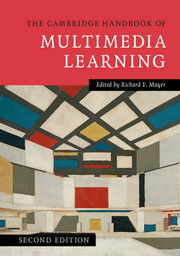Book contents
- The Cambridge Handbook of Multimedia Learning
- The Cambridge Handbook of Multimedia Learning
- Copyright page
- Contents
- Contributors
- Preface
- Acknowledgments
- 1 Introduction to Multimedia Learning
- Part I Theoretical Foundations
- 2 Implications of Cognitive Load Theory for Multimedia Learning
- 3 Cognitive Theory of Multimedia Learning
- 4 Integrated Model of Text and Picture Comprehension
- 5 The Four-Component Instructional Design Model: Multimedia Principles in Environments for Complex Learning
- Part II Basic Principles of Multimedia Learning
- Part III Advanced Principles of Multimedia Learning
- Part IV Multimedia Learning of Cognitive Processes
- Part V Multimedia Learning in Advanced Computer-Based Contexts
- Author Index
- Subject Index
3 - Cognitive Theory of Multimedia Learning
from Part I - Theoretical Foundations
Published online by Cambridge University Press: 05 August 2014
- The Cambridge Handbook of Multimedia Learning
- The Cambridge Handbook of Multimedia Learning
- Copyright page
- Contents
- Contributors
- Preface
- Acknowledgments
- 1 Introduction to Multimedia Learning
- Part I Theoretical Foundations
- 2 Implications of Cognitive Load Theory for Multimedia Learning
- 3 Cognitive Theory of Multimedia Learning
- 4 Integrated Model of Text and Picture Comprehension
- 5 The Four-Component Instructional Design Model: Multimedia Principles in Environments for Complex Learning
- Part II Basic Principles of Multimedia Learning
- Part III Advanced Principles of Multimedia Learning
- Part IV Multimedia Learning of Cognitive Processes
- Part V Multimedia Learning in Advanced Computer-Based Contexts
- Author Index
- Subject Index
Summary
A fundamental hypothesis underlying research on multimedia learning is that multimedia instructional messages that are designed in light of how the human mind works are more likely to lead to meaningful learning than those that are not so designed. The cognitive theory of multimedia learning is based on three cognitive science principles of learning: the human information processing system includes dual channels for visual/pictorial and auditory/verbal processing (i.e., dual-channel assumption), each channel has a limited capacity for processing (i.e., limited-capacity assumption), and active learning entails carrying out a coordinated set of cognitive processes during learning (i.e., active processing assumption). The cognitive theory of multimedia learning specifies five cognitive processes in multimedia learning: selecting relevant words from the presented text or narration, selecting relevant images from the presented graphics, organizing the selected words into a coherent verbal representation, organizing selected images into a coherent pictorial representation, and integrating the pictorial and verbal representations and prior knowledge. Three demands on the learner’s cognitive capacity during learning are extraneous processing (which is not related to the instructional objective), essential processing (which is needed to mentally represent the essential material as presented), and generative processing (which is aimed at making sense of the material). Three instructional goals are to reduce extraneous processing (for extraneous overload situations), manage essential processing (for essential overload situations), and foster generative processing (for generative underuse situations). Multimedia instructional messages should be designed to guide appropriate cognitive processing during learning without overloading the learner’s cognitive system.
- Type
- Chapter
- Information
- The Cambridge Handbook of Multimedia Learning , pp. 43 - 71Publisher: Cambridge University PressPrint publication year: 2014
- 560
- Cited by

